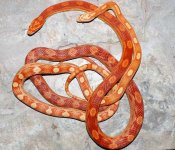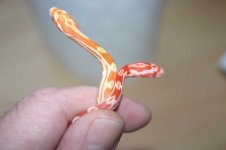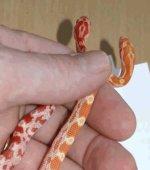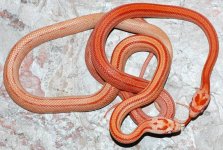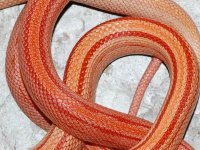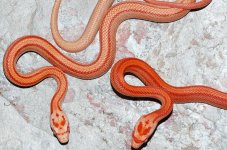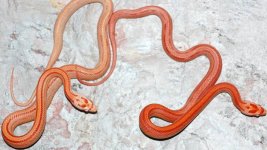My first impression of the Brown/Yellows is CARAMEL, but a dominant yellow gene may mimic Caramel. There is an ongoing debate about whether or not Caramel is recessive or co-dominant. The reason many people believe that Caramel is co-dominant and not recessive is because hets for Caramel can be extremely yellow.
I jumped on the Carmel is co-dominant bandwagon, after two years of breeding a few homo Caramels such as Male Striped Butters and a Male Butter Motleys that I obtained from Rich Z. When I bred them to Amels, they screamed YELLOW and look exactly like your “Lutinos”. When I bred them and produced Normals, they screamed YELLOW as well. This year, I bred quite a few Het Caramels to non-caramel carriers and should have been able to easily see the Het Caramels in the clutches, but it was not as easy as it should have been. Also, some of my homo Caramels did not produce the yellows in het offspring, like the two males had. There was a difference in color of the Homo Caramels that produced yellows and the ones that did not. The ones that produced the het yellow offspring, were more saturated with yellow and the shade of color was deeper.
The debate over whether or not Caramel is co-dominant or recessive waged on, and then Rich Z responded on one of threads and he adamantly believes that Caramel is recessive and can not be seen as het. Who is going to argue with the discover of the gene? Many people believe that the cause of the yellow het offspring is simply the result of selectively breeding for yellow in the Caramel line, but it seems to be such an on/off type occurrence when it happens, and it is not diluted by out crossing much at all.
I suggested in this thread that there is another possibility. A new co-dominant yellow gene could have easily been bred into and heavily mixed into the Caramel line. If this had happened, then some of us would see this co-dominant or dominant yellow gene in hets, and others with Caramels that did not have this gene, would not see yellow in their hets. It sounds like the gene is dominant exactly like the Hypo Boa gene is. A Homo Hypo Boa and a Het Hypo Boa look exactly the same. If this is the case with the “Yellow” gene, then it would appear to mimic a recessive gene when Het Yellow X Het Yellow or Het Yellow X Normal is bred together, but your last Yellow Amel X Yellow Amel Clutch, could have easily been a Homo Yellow X Homo Yellow breeding and the entire clutch would be homo for Yellow or if it was a Homo Yellow X Het Yellow breeding the entire clutch would be yellow as well. In the Boa World these are called SUPERS !!!!, because you can breed them to anything and produce a clutch of 100% Het Yellows and they will all look like Yellows.
I think the possibility of a new dominant Yellow gene that has been mixed in with the Caramel line makes much more since than selective breeding to cause more yellow. Look at this photo that I have attached. The breeding was a Butter Motley X Red Amel Motley like the Red Amel Motley in the comparison photo and BAM!!, the entire clutch had a strong yellow wash to it. That is some pretty strong selective bred yellow coloration, because it didn’t get diluted much at all. When you breed a Butter Motley to one of these Yellow Amels, you get all Yellow Amels, but they are not more intensely saturated with yellow coloration, they look exactly the same, just like a Homo Dominant and Het Dominant gene would.
Several years ago, Don S and I traded some “Snake Candy” for fun. He sent me some Amels poss het Striped Butter, that were extremely yellow and look exactly like the Yellow Amels. The first year, one of the Amel poss het Striped Butter was bred to a Striped Butter, and Butter Motleys were produce. It was het for Caramel, but was het for Motley and not Striped. This year, I had a Yellow Amel Striped sibling to the Amel het Butter Motley produce eggs and I was practically 100% positive that it was het for Caramel. I produced 100% Yellow Amel Stripes exactly like the mother.
I think based upon the co-dominant vs. recessive debate about Caramel, my breeding results and now your Dominant Yellow breeding results, without Caramel in the line, all evidence weights heavily for there being a newly discovered dominant Yellow gene in our Corns.

